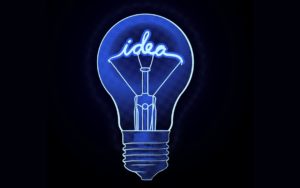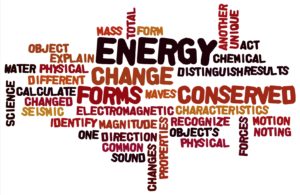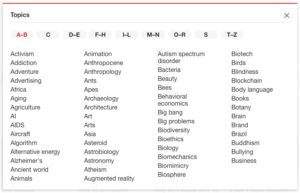RESOURCES
Finding Big Ideas
Jun 23, 2020
 “Big Ideas are broad concepts that are explored in multiple ways and are relevant to the Learners, and the larger community (e.g., health).”
“Big Ideas are broad concepts that are explored in multiple ways and are relevant to the Learners, and the larger community (e.g., health).”
Challenge Based Learning Guide
The starting point for developing a challenge experience is a Big Idea. It can be identified by the senior learner beforehand or with the junior learners as a first step of the journey. Big Ideas are “broad concepts that are explored in multiple ways and are relevant to the Learners and the larger community.” The beauty of the Big Idea is that they allow for contextualization and ownership. The Big Ideas of Health, Water and Resilience are going to be interpreted differently depending on context, circumstances, and timing and will lead to uniquely personal learning experiences and solutions.
Big Ideas are all around us. Read, look, talk with people, listen and the Big Ideas will emerge. They do not have to be earth-shattering or have the capacity to create solutions that are world changing – they first need to be relevant to the learners and their community. The learners include both the senior (teachers, parents) and the junior (students) participants. The community can be as large as the world or as small as the home and classroom.
When identifying and agreeing upon Big Ideas, it is critical to stop and get a pulse on what is relevant to the learners. If there is something of immediate relevance and concern, this is the optimal Big Idea because it creates an urgency to identify and solve the resulting challenge.
For example, if everyone is concerned about their upcoming AP test this should be the Big Idea because it is the most relevant issue to the learners and the local community (class). If we ignore the pressing Big Ideas and focus on ones with limited relevance, it will be a struggle.
With this said the learners could broaden the Big Idea from the test ( to assessment) and bring in other concerns (health, competition, definitions of success, statistics, etc.) through the essential questioning, challenge and guiding questions.
Here are some ideas for developing and reaching consensus on Big Ideas:
The passion (or concern) walk. Have all of the learners individually make a list of items that they are passionate (or concerned about). Decide ahead of time if it makes more sense to focus on passions or concerns and make sure to define these terms before the activity. Once the learners (and the senior leaners should participate as well) create a list have them select the top passion (or concern). Then work to reduce it to a keyword (a teachable moment on what keywords are and how they work) and write them on paper, card or a device if everyone has them. When everyone has selected their keyword (s) have them walk around the room with the words visible and discuss the Ideas. Finally, have them “clump” together around shared ideas and see if they can agree on a keyword that represents their concerns.
Tools: paper, pens
Create mind-maps (tools/apps) to help brainstorm, organize, categorize, and even prioritize ideas and how they connect. Having access to tools like these help provide a way to assess and adjust where needed. Instead of jumping into a narrative (start, middle, and end) document— learners can look at the structure of any project like this. Here is a quick example of a basic plan to help learners ask the right questions, generate the needed guiding activities to answer the questions.
Tools: bubble.us, FreeMind, XMind
Photo Essay – Grab those phones, cameras, etc and take a walk around the community or school and take pictures of issues and concerns. Review and group the photos by Big Ideas (e.g. pollution, waste, graffiti, traffic). This activity can create a teachable moment for pattern recognition and understanding diagrams
Tools: For quick slideshows to help organize and showcase the collected images— you can use apps like Photos slideshow for iOS, Quick, Google SlideShow, FilmoraGo, PixGram.

Standards, Goals, Objectives Word Maps – Big Ideas can even be found in the official curriculum documents. In many schools, the standards are the most pressing concern of the adult learners. So take all the text for a specific area or unit and create a Word Map. For example, this is a Word Map of the Colorado 8th grade Physical Science Grade-level Expectations at a Glance. Looks like Energy and Change might be interesting Big Ideas to pursue. You can also mix subject area standards and get an interdisciplinary word map.
Tools: wordle.net, wordclouds.com
Big Idea Wall – keep a space in the room (or on the Internet) where students can post pictures, words, drawings, lyrics, etc. that strike them as Big Ideas. This collection can be mined throughout the year for Big Ideas to guide class, group or individual challenges.
Tools: Bulletin board, tacks, paper. For digital collections – blogs, DropBox, Google Drive,
Guest Speakers – work with local organizations or the city to speak to the learners about local issues and concerns. Most cities have identified a set of concerns and improvement goals. For example, one school worked with the city on the Big Idea of Graffiti and through their challenge learned about city government, laws and policies, human behavior, art, science, and math while developing solutions to pitch to city officials.
Tools: Websites, email, phone
Ted Talks Keyword Search – The Ted Talks website (https://www.ted.com/talks) includes a collection of presentations by “expert speakers on education, business, science, tech and creativity” Visit the site, select Topics > See All Topics and you can explore by Keyword. The extensive list contains a treasure trove of Big Ideas that are connected with expert presentations.

Tools: Web Browser
Reflect:
What ideas and tools do you have for generating Big Ideas? Let us know at #CBLWorld #BigIdeas or email
